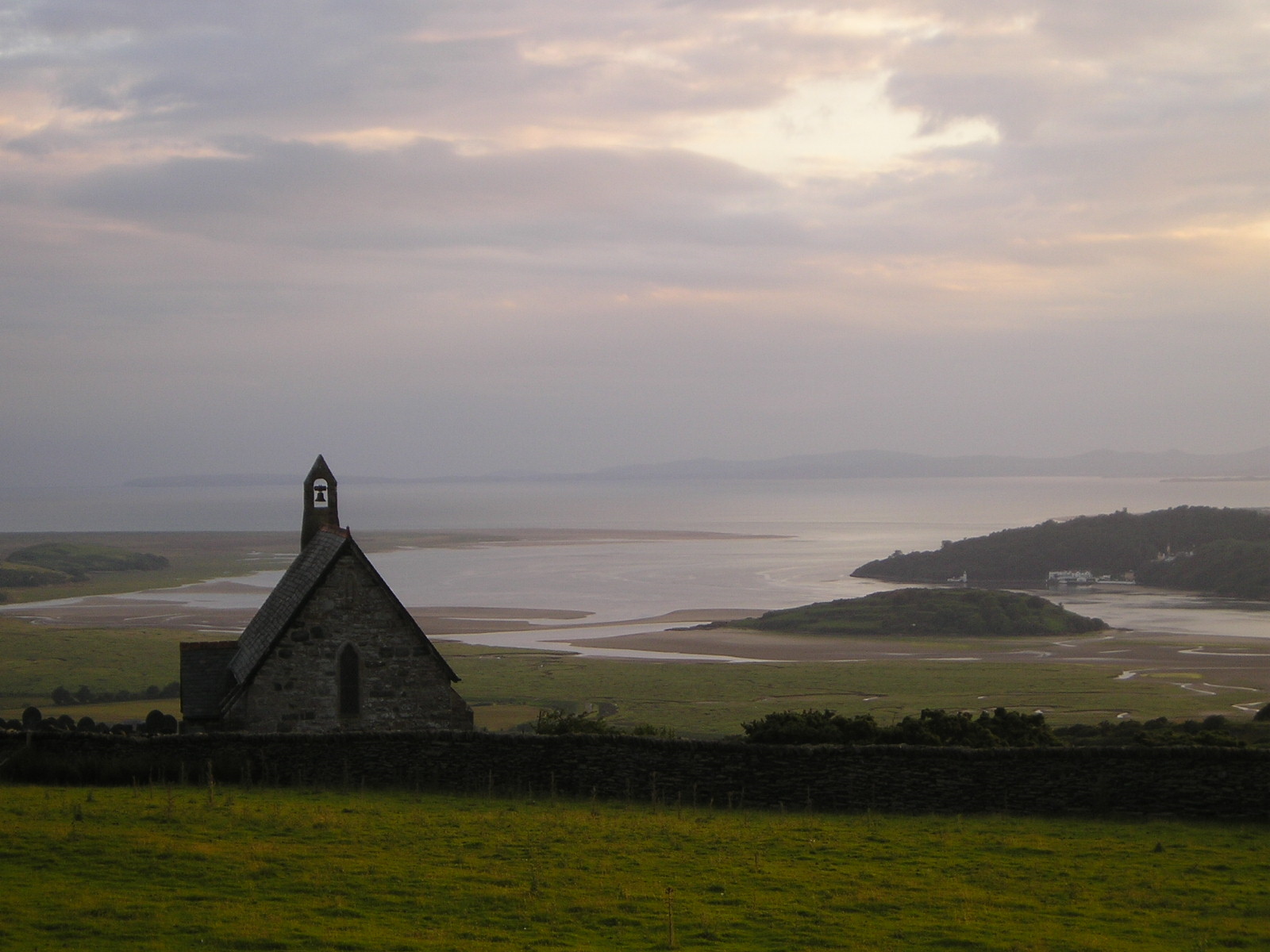Eglwys Llandecwyn Church (January 1983)
"Hen Eglwys wen,gwelais hi,
A dwrn oes galed arni". J. E.
( this Church shows the stamp of hard times)

This Church enjoys the most beautiful panorama of Traeth Mawr and Traeth Bach to Pen Llyn in a circle through to include Eryri and Moelwyn Mawr. The knowledgable traveller will find this Church on the top of a hill with its tower reaching the Heavens. Although its position is pleasant it has its disadvantages because of the constant strong coastal winds of Bae (Bay) Ceredigion and the harsh East winds that have battered her over the years. The Cemetery Porch has been recently renovated, and re-slated with aged slates (probably older than the present Church) in order to keep its character, by Cyngor Cymuned Llandecwyn Community Council. There is no need either to be a professional to realise that Ty'n Llan, next door looks much older than the present Church. There is an unclear date 16?? on the West side and I believe dates back much further. Across the road to Ty'n Llan and Porch lies a green patch where the Parishioners gathered together to play games such as wrestling, cock fighting, fairs and festivities. This spot was surely a popular meeting place because Ty'n Llan had been an Inn and a School in its time. It is sad to feel that the road has been ignored by the powers that be and the old Seintwar (Church) pulled down in our lifetime and we have a responsibility to preserve these buildings.
Worshipping on this site has happened since the 6th Century and according to Historians the present Church could be the 3rd if not 4th building here. Although there is no written proof, it was originally a Celtic Church then consecrated to St Tecwyn as Mihangel, Tanwg, Brothen and Twrog in a primitive period in this part of Ardudwy. Adjacent to the graveyard wall there is a fairly flat field which is called Cae Maen Tecwyn to the present day. According to tradition here was a huge stone where the community gathered together to listen to wiser men than most preaching, which in time, influenced people to build a sort of building to shelter the Altar where they gathered to Worship.
The earliest building was probably a wooden one and in all probability according to the old characters of Plas, Llandecwyn, the enormous stone was broken and used to build the second Church. Worshipping happened here according to the stone with ancient writing on it. This stone was moved from the inside chancel a few years ago. It would be advantageous if this stone could be preserved in a safe place so that it can be seen by many who are interested in antiquities.
In 1880, the same year as Capel Brontecwyn was built at Croesffordd Bryn y Bwa Bach (Crossroads), further down, the Church was re- built. This activity was a great feat in dedication of the people at a time of great hardship compared to the luxury and indifference of life today. It is interesting to note the costs of rebuilding 103 years ago. The complete work cost £493 11s. 2p with contributions amounting to £470. 1s. 7p.
Tradesmen were paid as follows:
£213.16s 1p. R Williams a J Hughes,Stonemasons
£50. 0. 0. Evan Jones Williams carpenter Pentre Farm , the great grandfather of Mrs Mair Griffiths, late of Groesnewydd and Evan Vaughan Jones.
£2.7s was paid to Robert Lloyd for nails etc. It is believed that he was a Shopkeeper at the Post Talsarnau and his surname named the High Street today - Lloyd Street at this time.
£111.18s 10p paid to J.H. Williams and Sons for timber,
£10 to Lewis Hughes for painting and glazing,
£30 0.9p for plastering and roofing T Humphreys and £12 12s as Registration fee
£21 was paid to the unknown Architect. Is this sum excessive considering the other contributions?
Subscriptions by Landowners as follows:
Oakleys, Tanybwlch, Lord Harlech, W T Poole Esq, Captain Kirkby, Maesyneuadd, G.E.Haigh, Esq, Grimsby & Caerffynnon, R D Wood, Esq. Rugby, Jones, Esq., Ynysfor. Other unfamiliar names – Adamson, Parnell, Hesketh, Fletcher, Digby, Kike- Hall, Platt etc. not knowing their connection with a country Parish and Church.
As we see the list of less fortunate Parishioners contribution it is sad to recall the names of small homesteads such as Brynmelyn on Coety Mawr land, Blaenddol at Caerwych, Muriau'r Gwyddel where stones were removed to build Plasdy Penbryn-pwll-du. Although it is sad to see the remains of places that I recall on reading the list, I may feel grateful that some of them still stand and being kept in good order although it may be weekend smoke that comes out of the chimneys and that the summer sun awakens them from slumber.
At the bottom of the list £1 3s 8p is shown as Minor Sums and I feel that a widowed lady without any support felt proud that her hard earned shilling was a contribution to such a worthy cause.
While we admire the sacrifices of our forefathers on their last great attempt in 1880 to ensure a place of worship, it is our duty as Believers to hand over what we received to the ones that follow us. Not only to feed our spiritual needs as this Church did for centuries followed by the chapels, we also need to guard and protect our language and culture. Our spiritual needs go hand in hand with our language and culture.


